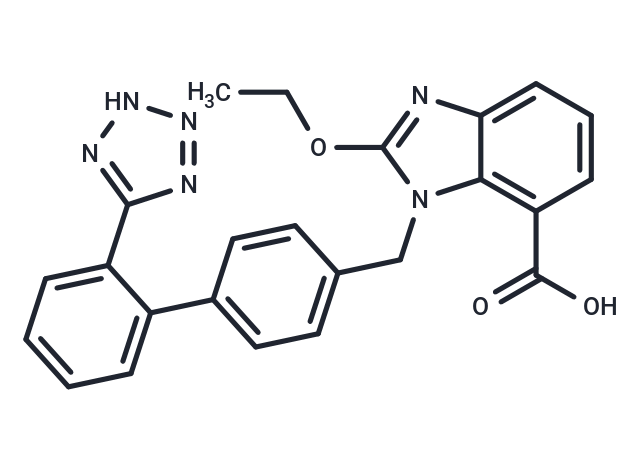Shopping Cart
- Remove All

Your shopping cart is currently empty


| Pack Size | Price | Availability | Quantity |
|---|---|---|---|
| 10 mg | $54 | In Stock | |
| 25 mg | $125 | In Stock | |
| 50 mg | $195 | In Stock | |
| 100 mg | $292 | In Stock | |
| 1 mL x 10 mM (in DMSO) | $50 | In Stock |
| Description | Candesartan (CV 11974) is an angiotensin II receptor blocker widely used in the treatment of hypertension and heart failure. |
| In vitro | In mice carrying KU-19-19 xenografts, Candesartan (10 mg/kg) reduced microvascular density and VEGF expression, inhibiting tumor cell growth. In WKY rats, a lower dose of Candesartan (0.5 mg/kg) decreased blood pressure and inhibited the binding of AT1 in various brain regions, including the subfornical organ, paraventricular nucleus of the hypothalamus, solitary tract nucleus, and the area postrema. Furthermore, in adult spontaneously hypertensive rats, Candesartan (0.3 mg/kg) reduced the infarct size, diminished severe ischemic lesions in the peri-infarct and subcortical areas, and lessened the decrease in cerebral blood flow. |
| In vivo | In CHO-AT1 cells, Candesartan binds with high selectivity to the angiotensin II AT1 receptors. At a concentration of 0.1 nM, Candesartan can reduce the maximum constrictive response to angiotensin II. Additionally, in KU-19-19 cells, the introduction of Candesartan leads to an upregulation of VEGF and interleukin-8 expression, without affecting cell proliferation. |
| Kinase Assay | Binding assay: Cells are plated in 24-well plates and cultured until confluence. Before the experiment, the cells are washed three times with 0.5 mL per well of DMEM at room temperature. After removal of the medium, 400 μL binding DMEM is added and the plate is then left for 15 min at 37 ℃. For saturation binding assays cells are incubated with increasing concentrations [3H]Candesartan (final concentrations between 0.15 nM and 15 nM) in a final volume of 0.5 mL at 37 ℃ for 5 min to 180 min. For competition binding assays 50 μL of buffer or 50 μL of buffer containing increasing concentrations of unlabelled Candesartan is added. After 30 min, 50 μL of buffer containing [3H]Candesartan (final concentration 1.1 nM) or [3H]Candesartan (final concentration 1.0 nM) is added, and the cells are further incubated for 30 min at 37 ℃. |
| Cell Research | KU-19-19 cells are seeded at a cell density of 2 × 104 per well in 96-well plates and allowed to grow overnight. Then the cells are treated with various concentrations of Candesartan for various periods of time. Cell viability is determined by the Alamar Blue assay to examine the cytotoxicity and antiproliferative effect of candesartan. The absorbance value of each well is determined in a microplate reade(Only for Reference) |
| Alias | CV 11974 |
| Molecular Weight | 440.47 |
| Formula | C24H20N6O3 |
| Cas No. | 139481-59-7 |
| Storage | Powder: -20°C for 3 years | In solvent: -80°C for 1 year | ||||||||||||||||||||||||||||||||||||||||
| Solubility Information | DMSO: 4.5 mg/mL (100 mM) Ethanol: 0.4 mg/mL (10 mM)), Heating is recommended. | ||||||||||||||||||||||||||||||||||||||||
Solution Preparation Table | |||||||||||||||||||||||||||||||||||||||||
Ethanol/DMSO
DMSO
| |||||||||||||||||||||||||||||||||||||||||

Copyright © 2015-2024 TargetMol Chemicals Inc. All Rights Reserved.